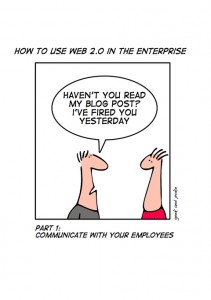
This afternoon I followed a webcast about the protection of your brand in the web 2.0 jungle. A fact is that the reputation of a brand built during years can be destroyed in only a few minutes! Think about that!
Just to remind you, the “web 2.0” is the huge amount of last generation websites which allow interaction with the visitors. Users are now able to publish their own content online in a few clicks (Like the article you’re reading now). A specific type of applications is the social network sites. Major players are Facebook, LinkedIn, Youtube or Twitter.
For a long time now, a lot of employers already use social networks for personal purposes. If they surf from the corporate network, the risk to see information about the company published is very high. They can disclose, event without explicit, interesting information about internal application or processes (Example on Facebook: “John is pissed off by xxx, this firewall is a real bullshit!“). Those data can be easily found by performing some social engineering and can be very useful for bad guys.
But today, organizations are also active on social networks for business purposes (for more collaboration between employees, for brand awareness and marketing actions or to increase productivity). A survey showed that 86% of ICT managers feel a pressure to allow access to web 2.0 apps. But in the same time, 91% of firms do not have any idea of the threats against online applications. In the past, the social networking sites were simply banned by firewalls or proxies.
Never trust your users. That’s why a “social media policy” must be defined and endorsed by the top-management. Lof of policy examples are available on socialmediagovernance.com. Why do you need such policy?
- First, if you don’t tell what to expect, expect it wrong!
- Your brand can be compromized and used against you.
- The content is highly dynamic and will be quickly indexed and reused in “clouds”. Impossible to control.
- They are risk of data leak
- Malicious code appeared in online applications and they are now a vector of infection.
Keep “control” of your brand and avoid cyber- squatting. Today, not only domain names are targets but keep an eye on URLs like “twitter.com/yourbrand” or “facebook.com/yourbrand“. It’s easy for an employee to register the company name on a social network and to communicate on it. This can be disastrous! In this case, we speak about “qualitative risks”, it’s not possible to estimate a profit loss ($) if this happens but the impact on your brand can be really important with respect to your customers, partners or shareholders.
Finally don’t forget to track the usage of your brand on the Internet. Google Alerts is a nice tool for this purpose. It will notify you when defined keywords are detected on web pages.